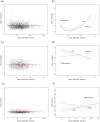The unique association between serum 25-hydroxyvitamin D concentrations and blood lipid profiles in agriculture, forestry, and fishing occupations: Insights from NHANES 2001-2014
- PMID: 38412162
- PMCID: PMC10898752
- DOI: 10.1371/journal.pone.0297873
The unique association between serum 25-hydroxyvitamin D concentrations and blood lipid profiles in agriculture, forestry, and fishing occupations: Insights from NHANES 2001-2014
Abstract
Background: The relationship of serum 25(OH)D levels and hyperlipidemia has not been explored in the Agriculture, Forestry, and Fishing (AFF) occupation. We aimed to explore the impact of serum 25(OH)D levels on lipid profiles in AFF workers, traffic drivers, and miners.
Methods: Data from 3937 adults aged 18-65 years old with completed information were obtained from the National Health and Examination Survey from 2001 to 2014. Multivariate linear regression models were used to examine the associations between serum 25(OH)D concentrations and triglycerides (TG), total cholesterol (TC), low-density lipoprotein cholesterol (LDL-C), high-density lipoprotein cholesterol (HDL-C) and HDL-C/LDL-C ratio. Subgroup analyses for AFF workers considered age, sex, BMI, work activity, months worked, and alcohol consumption. Non-linear relationships were explored using curve fitting.
Results: Serum 25(OH)D levels differed between groups (AFF: 60.0 ± 21.3 nmol/L, drivers: 56.6 ± 22.2 nmol/L, miners: 62.8 ± 22.3 nmol/L). Subgroup analysis of the AFF group showed that participants with serum 25(OH)D ≥50 nmol/L, females, and BMI <30 kg/m2 demonstrated improved HDL-C levels correlating with higher serum 25(OH)D. Serum 25(OH)D in AFF workers had a reversed U-shaped relationship with TG and TC, and a U-shaped relationship with HDL-C, with HDL-C, with inflection points at 49.5 nmol/L for TG and TC, and 32.6 nmol/L for HDL-C.
Conclusions: Serum 25(OH)D levels are associated with lipid profiles, and the relationship varies among occupational groups. AFF workers, facing unique occupational challenges, may benefit from maintaining adequate serum 25(OH)D levels to mitigate adverse lipid profiles and reduce cardiovascular risk.
Copyright: © 2024 Zhang, Dong. This is an open access article distributed under the terms of the Creative Commons Attribution License, which permits unrestricted use, distribution, and reproduction in any medium, provided the original author and source are credited.
Conflict of interest statement
The authors have declared that no competing interests exist.
Figures



Similar articles
-
Associations between body mass index and all-cause and CVD mortality in agriculture, forestry, and fishing occupations: A prospective cohort study using NHANES data (1999-2014).PLoS One. 2024 Jul 8;19(7):e0305922. doi: 10.1371/journal.pone.0305922. eCollection 2024. PLoS One. 2024. PMID: 38976691 Free PMC article.
-
Association between early pregnancy vitamin D status and changes in serum lipid profiles throughout pregnancy.Metabolism. 2017 May;70:85-97. doi: 10.1016/j.metabol.2017.02.004. Epub 2017 Feb 12. Metabolism. 2017. PMID: 28403948
-
Association of 25-hydroxyvitamin D levels with lipid profiles in osteoporosis patients: a retrospective cross-sectional study.J Orthop Surg Res. 2023 Aug 14;18(1):597. doi: 10.1186/s13018-023-04079-8. J Orthop Surg Res. 2023. PMID: 37574564 Free PMC article.
-
Vitamin D and metabolic health with special reference to the effect of vitamin D on serum lipids.Prog Lipid Res. 2011 Oct;50(4):303-12. doi: 10.1016/j.plipres.2011.05.001. Epub 2011 May 27. Prog Lipid Res. 2011. PMID: 21640757 Review.
-
Effects of α-linolenic acid intake on blood lipid profiles:a systematic review and meta-analysis of randomized controlled trials.Crit Rev Food Sci Nutr. 2021;61(17):2894-2910. doi: 10.1080/10408398.2020.1790496. Epub 2020 Jul 9. Crit Rev Food Sci Nutr. 2021. PMID: 32643951
Cited by
-
Association between dietary vitamin K intake and lipid metabolism among populations with cardiovascular disease.Front Nutr. 2025 Jul 4;12:1605300. doi: 10.3389/fnut.2025.1605300. eCollection 2025. Front Nutr. 2025. PMID: 40686819 Free PMC article.
-
Association between dyslipidemia and vitamin D deficiency: a cross-sectional study in Chinese healthy population.Front Endocrinol (Lausanne). 2025 Apr 30;16:1450924. doi: 10.3389/fendo.2025.1450924. eCollection 2025. Front Endocrinol (Lausanne). 2025. PMID: 40370783 Free PMC article.
-
Associations between body mass index and all-cause and CVD mortality in agriculture, forestry, and fishing occupations: A prospective cohort study using NHANES data (1999-2014).PLoS One. 2024 Jul 8;19(7):e0305922. doi: 10.1371/journal.pone.0305922. eCollection 2024. PLoS One. 2024. PMID: 38976691 Free PMC article.
References
-
- Karr S. Epidemiology and management of hyperlipidemia. AM J MANAG CARE. 2017;23(9 Suppl):S139–S48. - PubMed
MeSH terms
Substances
LinkOut - more resources
Full Text Sources
Medical
Miscellaneous

